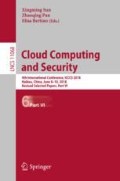Abstract
Smart transportation system is a cross-field research topic involving a variety of disciplines, in which data plays a central role. Researches that are driven by data can be traced back to the 1930s, when the British statistician and biologist Ronald Fisher creates the Iris dataset to study the objective and automated way to classify iris flower. Early success of data powered research illustrates the potential value of data in the research topics in either scientific or social domains. City transportation system is one of the most fundamental components of the city service. Recent researches show that the quality of the transportation service largely depends on how well its resources can be managed and utilized, which in turn relies on how well the data derived from that system can be collected and processed for the need of the government authority, as well as any individual citizen. Improvements on the transportation via the smart transportation system do not only pose an important impact on any individual’s life style, but it is also a great saving of time and energy.
Access this chapter
Tax calculation will be finalised at checkout
Purchases are for personal use only
References
Zhang, J.P.: Data-Driven intelligent transportation systems: a survey. IEEE Trans. Intell. Transp. Syst. 12(4), 1624–1639 (2011)
Faouzi, N.E.E.: Data fusion in intelligent transportation systems: Progress and challenges – a survey. Inf. Fusion 12(1), 4–10 (2011)
Lee, D.H.: Applying data mining techniques for traffic incident analysis. J. Inst. Eng. 44(2), 90–102 (2004)
Shena, Y.: Investigating commuting flexibility with GPS data and 3D geovisualization: a case study of Beijing, China. J. Transp. Geogr. 32(7), 1–11 (2013)
Liu, B.S.: Research on forecasting model in short term traffic flow based on data mining technology. ISDA 1, 707–712 (2006)
Vanajakshi, L.: Travel time prediction under heterogeneous traffic conditions using global positioning system data from buses. IET Intell. Transp. Syst. 3(1), 1–9 (2009)
Ren, F.: Geovisualization of human hybrid activity-travel patterns. Trans. GIS 11(5), 721–744 (2007)
Ahas, R.: Evaluating passive mobile positioning data for tourism surveys: an estonian case study. Tour. Manag. 29(3), 469–486 (2008)
Lint, J.W.C.V.: A robust and efficient method for fusing heterogeneous data from traffic sensors on freeways. Comput.-Aided Civ. Infrastruct. Eng. 25(8), 547–629 (2010)
Zhang, Y.: Expanding bicycle-sharing systems: lessons learnt from an analysis of usage. PLoS ONE 11(12), e0168604 (2016)
O’Brien, O.: Mining bicycle sharing data for generating insights into sustainable transport systems. J. Transp. Geogr. 34(219), 262–273 (2014)
Ming, S.: On the structure of weekly activity/travel patterns. Transp. Res. Part A: Policy Pract. 37(10), 823–839 (2003)
Kwan, M.P.: GABRIEL: Gis Activity-Based tRavel sImuLator. Activity scheduling in the presence of real-time information. GeoInformatica 10(4), 469–493 (2006)
Ahas, R.: Daily rhythms of suburban commuters’ movements in the Tallinn metropolitan area: case study with mobile positioning data. Transp. Res. Part C: Emerg. Technol. 18(1), 45–54 (2010)
Kwan, M.P.: Interactive geovisualization of activity-travel patterns using three-dimensional geographical information systems: a methodological exploration with a large data set. Transp. Res. Part C: Emerg. Technol. 8(1–6), 185–203 (2000)
Wang, Z.C.: Visual traffic jam analysis based on trajectory data. IEEE Trans. Vis. Comput. Graph. 19(12), 2159–2168 (2013)
Moretti, F.: Urban traffic flow forecasting through statistical and neural network bagging ensemble hybrid modeling. Neurocomputing 167(1), 3–7 (2015)
Lippi, M.: Short-Term traffic flow forecasting: an experimental comparison of time-series analysis and supervised learning. IEEE Trans. Intell. Transp. Syst. 14(2), 871–882 (2013)
White, T.: Hadoop: The Definitive Guide, 3rd edn. O’Reilly, Sebastopol (2012)
Zaharia, M.: Spark: cluster computing with working sets. Usenix Conf. Hot Top. Cloud Comput. 15(1), 10–18 (2010)
GEP Box.: Time Series Analysis: Forecasting and Control (3rd edn.). J. Time 31(4), 199–201 (1994)
Nelson, J.: Mastering Redis. Packt Publishing, Birmingham (2016)
Goodfellow, I.: Aaron Courville. Deep Learning. MIT Press, Cambridge, MA (2016)
Hochreiter, S.: Long short-term memory. Neural Comput. 9(8), 1735–1780 (1997)
Richard, S.: Reinforcement Learning: An Introduction. MIT Press, Cambridge, MA (1998)
Cheng, J.R.: An abnormal network flow feature sequence prediction approach for DDoS attacks detection in big data environment. CMC Comput. Mater. Continua 55(1), 95–119 (2018)
Yıldızel, S.A.: A study on the estimation of prefabricated glass fiber reinforced concrete panel strength values with an artificial neural network model. CMC: Comput. Mater. Continua 52(1), 41–52 (2013)
CRWu.: Time optimization of multiple knowledge transfers in the big data environment. CMC: Comput. Mater. Continua, 54(3), 269–285 (2018)
Acknowledgement
The work is supported by the National Natural Science Foundation of China under grant No. 61702305, the China Postdoctoral Science Foundation under grant No. 2017M622234, Scientific Research Foundation of Shandong University of Science and Technology for Recruited Talents under the grant No. 2016RCJJ045.
Author information
Authors and Affiliations
Corresponding author
Editor information
Editors and Affiliations
Rights and permissions
Copyright information
© 2018 Springer Nature Switzerland AG
About this paper
Cite this paper
Zhang, Y. et al. (2018). Smart Transportation Systems for Cities in the Framework of Future Networks. In: Sun, X., Pan, Z., Bertino, E. (eds) Cloud Computing and Security. ICCCS 2018. Lecture Notes in Computer Science(), vol 11068. Springer, Cham. https://doi.org/10.1007/978-3-030-00021-9_7
Download citation
DOI: https://doi.org/10.1007/978-3-030-00021-9_7
Published:
Publisher Name: Springer, Cham
Print ISBN: 978-3-030-00020-2
Online ISBN: 978-3-030-00021-9
eBook Packages: Computer ScienceComputer Science (R0)

